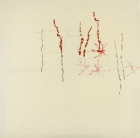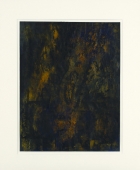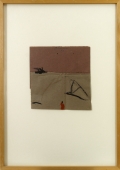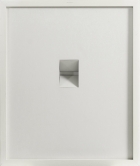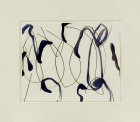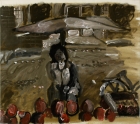
Artist | Ilya Iosifovich Kabakov (1933 - 2023)
Alias: Ilya Iosifovich Kabakov [Ilya Kabakov. Kabakow]
https://www.artist-info.com/artist/Ilya-Kabakov
Biography (english / deutsch)
Biography (english / deutsch)
Born in the Ukrainian town of Dniepropetrovsk in 1933, Ilya Kabakov has lived in the West since leaving the USSR in 1988, but, as he once said in an interview with Boris Groys, he is still "shouldering the burden of Russia ". In his work, Ilya Kabakov addresses the systems and structures that have influenced him.
Der 1933 in Dnjepropetrowsk, in der Ukraine geborene Künstler lebt seit seiner Ausreise aus der UdSSR im Jahr 1988 zwar im Westen, er schleppt aber "Rußland als eine Last auf dem Buckel" mit sich herum, wie er es selbst in einem Interview gegenüber Boris Groys formuliert hat. Ilya Kabakov verweist mit seinem Werk auf Systeme und Strukturen, die ihn geprägt haben.
About the work (english / deutsch)
About the work (english / deutsch)
In General
In his brief and distinctly literary autobiography, Ilya Kabakov writes: "From 1982 onwards, creation of a person, namely of the 'small person' who never throws anything away in his life, the idea of 'garbage' as the history of his life."
It is the blend of emotional content - sometimes autobiographical, at other times fictional - and brusque constructive form in his spatial works that creates what he describes as "total installation". This has become his artistic strategy.
Kabakov links literary forms such as biographical texts, dialogues and swear words with the spatial presence of a semi-renovated exhibition area which gives the impression of a building site.
The Rope of Life and other Installations
Along the wall, small pieces of all kinds garbage are dangling from a rope that acts as a kind of guideline. Little white signs designate the individual "sculptures", and the texts they bear create an imaginary dialogue, a contradictory babble, that swells in the imagination of the spectator like a "sea of voices".
The written word, an essential element of the installation, has been painstakingly printed by hand with a neatness that recalls the precision and order of book-keeping, inventories, archives, files etc. We are also reminded of the classical signs we find in museums of history and natural sciences.
Everything radiates the spirit of perfect lovelessness. With a fine sense of irony, Kabakov has merely created signs to label items of garbage which, seen at close quarters, become a collection of small objects. We find ourselves confronted with the artefacts of "everyday" life. The artist has integrated the commentary into the work. The caption refers to situations as trivial and commonplace as the garbage objects themselves. We soon give up our attempts to distinguish between the important and the unimportant, the essential and the coincidental. Kabakov is interested in conserving and registering ephemeral, seemingly redundant fragments of the past and memory that have already become garbage. The objects become "the garbage of life ".
In Kabakov's work, garbage has no negative connotation. It stands for time lived. Each of the objects originally had a function. Even as garbage, they retain their value as a means of recalling life lived. The garbage also stands for the anonymous and the coincidental. Garbage becomes a metaphor of human existence, and of society as a whole. Kabakov's work never seems moralistic or admonishing; the prevailing atmosphere one of almost light-hearted wit and irony. "The installation un-doubtedly has to do with the inflation of the valuable and the material in the real world" (Kabakov, autumn 1990). Kabakov's work is deeply rooted in Russian life and its specific reality - a reality that plays on the tragicomedy of everyday life in Moscow.
The installation as environment contains an element of eventfulness. It is created for a certain period and then dismantled. It exists on as an imitation. The installation as artform demands proximity and distance at the same time. It is extremely fragile and unstable, for all the ruggedness of its building site appearance.
The actual installation with the title On the Edge includes the brown of the wall, the rope spanned along it with the garbage objects, the floor with its strips of paper, the pot of paint and the wooden boards. These form the framework for three further groups of work. The Rope of Life lies casually on the floor. The Box with Garbage includes a chair. And there is a ball of crumpled up paper in the corner of the room. Together with the narrative text of the accompanying sign, it becomes the fulcrum point of the entire installation - an existence on the edge: "No matter where I was, I have always felt as though I was standing, living in the corner ... everything I thought about, everything I did, came out of the corner ... and there was always that fear of stepping out of it und arriving in the middle - I was afraid of that, but I did not know what to do. In the corner, however, I felt safe, concentrated, full of energy ... I have spent my life in the corner."
The biographical fragments in The Rope of Life chart the life of a Russian artist from his birth in 1933 to his first exhibition in the West (Berne, 1985). The signs, each allocated to a garbage object, tell of hunger, cold, angst, fear, loneliness and yearning, but they also tell of "festivities in the forests near Nusberg - dancing at night amongst the trees" and they tell time and time again the names of people, companions; they tell of friendships. Kabakov's work is like a topographic sketch of memory and presence, like the "picture" of an inner landscape.
The chair as Part of the Box with Garbage ensemble gives the impression that someone sat there before and started to remove objects from the box. It is a very simple and already quite shabby box, of the kind normally used for transportation. Each object here also has a label. A few objects have already been selected and set beside the box. The pieces of white paper that look like price tags are inscribed with the most vulgar insults, certain to shock and appal any sensitive person. It is as though someone had stopped in the midst of unpacking and examining the contents of the box, perhaps thinking something like: "I'm not interested in the garbage anyway, and I'm certainly not going to stand for this kind of insult." The chair, seen as a figure, represents the absent person. (It bears comparison with other works in the museums collection such as Reinhard Muchas Mutterseelenallein, 1991, Reiner Ruthenbeck's Umgekippte Möbel, 1971, and Robert Watts' Chair, 1962). It was Kabakov's express wish that a translation of the texts should be included in the installation. The book he designed, published to coincide with the completion of the installation in the Museum für Moderne Kunst, complements the relationship between image and text. His spatial work The Rope of Life and other installations has been shown in modified form in New York (Ronald Feldman Gallery, 1988), Amsterdam (Stedelijk Museum, 1990) and Santa Monica (Fred Hoffman Gallery, 1990). The photos in the appendix to the artist's book show the prototype being set up in his Moscow studio. The Rope of Life and other installations was donated to the Museum für Moderne Kunst in 1994 by Ilya Kabakov.
German text by Mario Kramer / Translation by Ishbel Flett
(Extract - Full printed version available in the Museum)
MMK - Museum für Moderne Kunst, Frankfurt am Main
Allgemeines
In Form einer Literarisierung schreibt Ilya Kabakov in seiner selbstverfaßten Kurzbiographie u. a.: "Ab 1982 Erschaffung einer Person, nämlich des 'kleinen Menschen', der in seinem Leben nichts wegwirft, Idee des 'Abfalls' als Geschichte seines Lebens."
Die Verbindung von emotionalen Inhalten, zum Teil autobiographischer, zum Teil fiktiver Natur, und einer konstruktiven, eher schroffen Form eines raumbezogenen Werkes bezeichnet Kabakov als "totale lnstallation". Sie wurde zur künstlerischen Strategie.
Kabakov verknüpft dabei literarische Formen wie biographische Texte, Dialoge und Schimpfworte alltäglichster Art mit der räumlichen Präsenz eines halbfertig renovierten Ausstellungsraumes, der den Eindruck einer Baustelle hinterläßt.
Das Seil des Lebens und weitere Installationen
Entlang der Wand, an einem umlaufenden Seil befestigt, das gleichsam zur Richtschnur wird, hängen kleine Stücke von Abfall unterschiedlichster Art und Herkunft. Schmale weiße Beschriftungsschilder bezeichnen einerseits die individuellen kleinen "Skulpturen", andererseits bilden die darauf festgehaltenen Texte einen imaginären Dialog, ein sich widersprechendes Stimmengewirr, das in der Vorstellung des Betrachters leise anhebt wie ein "Meer von Stimmen".
Die Schrift, ein wesentliches Element der Installation, ist feinsäuberlich von Hand in Druckschrift gefertigt, sie erinnert an buchhalterische Ordnung von Inventaren, Archiven, Beschriftung von Akten und ähnlichem. Man denkt aber auch an klassische Exponatbeschriftungen in historischen und Naturkundemuseen. Alles strahlt den Geist perfekter Lieblosigkeit aus. Mit feiner Ironie beschriftet Kabakov eigentlich nur Abfall, der dann von nahe betrachtet zu einer Sammlung von kleinen Objekten wird. Man stößt dabei auf Begebenheiten eines "gewöhnlichen" Lebens. Der Kommentar wurde vom Künstler ins Werk integriert. Die Bildlegende verweist auf genauso triviale und alltägliche Situationen wie die Abfallobjekte selbst. Man gibt schnell auf, Wichtiges von Unwichtigem, Wesentliches von Zufälligem zu unterscheiden. Kabakovs Interesse gilt dem Bewahren und Registrieren flüchtiger, scheinbar unnötiger und bereits zum Abfall gegebener Fragmente der Vergangenheit und der Erinnerung. Die Objekte werden zum "Abfall des Lebens".
Der Müll hat in Kabakovs Werk keine negative Konnotation. Er steht für gelebte Zeit. Jeder der Gegenstände hatte ursprünglich eine Funktion. Sie haben auch als Abfall den Wert von Erinnerung an gelebtes Leben. Der Abfall steht auch für das Anonyme, das Zufällige. Der Müll wird zur Metapher für das menschliche Dasein, ja für die Gesellschaft. Kabakovs Werk wirkt dabei nie moralisierend oder düster mahnend, vielmehr herrscht eine fast heitere Stimmung voll Witz und Ironie. "Zweifellos steht die Installation mit der Inflation des Wertvollen und Materiellen in der realen Welt in Verbindung" (Kabakov, Herbst 1990). Kabakovs Werk ist tief im russischen Leben und seiner spezifischen Realität verwurzelt. Diese spielt mit der tragikomischen Wirklichkeit des Moskauer Alltags.
Die Installation als Environment enthält das Element der Ereignishaftigkeit. Sie entsteht für einen gewissen Zeitraum und wird anschließend aufgelöst. Sie existiert dann nur noch als Nachbild. Die Installation als Kunstform fordert vom Betrachter Nähe und Distanz zugleich. Sie ist in ihrer Gestalt überaus fragil und instabil, so grob der Baustellencharakter auch wirken mag.
Zur eigentlichen Rauminstallation mit dem Titel Am Rande gehören die braune Wandfarbe, das daran entlang gespannte Seil mit den Abfallobjekten, der mit Papierbahnen ausgelegte Boden, der Farbeimer und die Holzstege. Sie bilden den Rahmen für drei weitere Werkgruppen. Das Seil des Lebens liegt wie eine lockere Figur am Boden. Zur Kiste mit Müll gehört ein Stuhl. Und ein zerknülltes Papier liegt In der Ecke des Raumes. Mit dem erzählerischen Text des dazugehörigen Beschriftungsschildes wird es zum Dreh- und Angelpunkt der gesamten Installation - eine Existenz am Rande: "Ganz gleich, wo ich mich befunden habe, ich habe mich immer so gefühlt, als stünde ich, als lebte ich in der Ecke ... Aus der Ecke kam alles, worüber ich nachdachte, was ich tat ... Und immer gab es die Furcht davor, herauszutreten und in die Mitte zu geraten - davor hatte ich Angst, dort hätte ich nicht gewußt, was tun. In der Ecke jedoch fühlte ich mich sicher, konzentriert, voller Energie ... Ich habe mein Leben in der Ecke verbracht."
Die biographischen Fragmente am "Seil des Lebens" beschreiben eine Lebensgeschichte eines russischen Künstlers vom Geburtsjahr 1933 bis zur ersten Ausstellung im Westen in Bern 1985. Die Beschriftungsschilder, die wiederum jeweils einem Abfallobjekt zugeordnet sind, erzählen von Hunger, Kälte, Angst, Furcht, Einsamkeit und Sehnsucht, aber dann auch von einem "Fest in den Wäldern bei Nusberg - Nachts Tanzen zwischen den Bäumen" und immer wieder Namen von Menschen, Weggefährten - Freundschaften. Das Werk Kabakovs gleicht einer Topographie von Erinnerung und Gegenwart, einem "Bild" einer inneren Landschaft. Der Stuhl als Teil des Ensembles mit der "Kiste mit Müll" erweckt den Eindruck, als hätte zuvor jemand darauf Platz genommen und begonnen, die Gegenstände aus der Kiste auszupacken.
Es handelt sich um eine sehr einfache und bereits ramponierte Transportkiste. Jeder Gegenstand trägt auch hier eine Beschriftung. Ein paar wenige, bereits ausgewählte Objekte wurden neben der Kiste abgelegt. Die weißen Papierstücke, die auch an Preisschilder erinnern, sind mit übelsten Beschimpfungen beschriftet, die ein zarteres Gemüt mit Sicherheit schockieren und zurückweisen. Das weitere Auspacken und Studieren des Kisteninhaltes wurde dann wohl auch unterbrochen, vielleicht nach dem Motto: "Was interessiert mich der Müll Oberhaupt, und derart beschimpfen lasse ich mich erst recht nicht." Der Stuhl, als Figur betrachtet, repräsentiert den ansonsten abwesenden Menschen. (Vergleiche in der Sammlung des Museums zu Werken von Reinhard Mucha, Mutterseelenallein von 1991, liegen nahe). Es war Kabakovs ausdrücklicher Wunsch, eine Übersetzung der Texte in die Installation zu integrieren. Ebenso ergänzt das von ihm gestaltete Künstlerbuch, das anläßlich der Fertigstellung der Rauminstallation im Museum für Moderne Kunst erscheint, das Verhältnis von "Bild" und Text. Das raumbezogene Werk The Rope of Life and other installations war in unterschiedlichen Konstellationen bereits in New York (Ronald Feldman GallM, 1988), Amsterdam (Stedelijk Museum, 1990) und Santa Monica (Fred Hoffman Gallery, 1990) ausgestellt. Die Fotos im Anhang des Künstlerbuches zeigen u.a. das Werk in einem Probeaufbau im Atelier des Künstlers in Moskau. The Rope of Life and other installations wurde 1994 dem Museum für Moderne Kunst von Ilya Kabakov geschenkt.
Text von Mario Kramer
(Auszug - Der vollständige Text ist als Informationsblatt beim Museum erhältlich)
MMK - Museum für Moderne Kunst, Frankfurt am Main
Bibliography
Bibliography
Kabakov, Ilya: Ilya Kabakov. The Rope of Life and other installations. Verlag Wilk, Friedrichsdorf, 1995.
ISBN: 3-88270-474-8
 offers / Requests offers / Requests  |
About this service |
|---|
 Exhibition Announcements Exhibition Announcements  |
About this service |
|---|
 Visualization |
Learn more about this service | ||
|---|---|---|---|

Interested in discovering more of this artist's networks?
3 easy steps: Register, buy a package for a visualization, select the artist.
See examples how visualization looks like for an artist, a curator, or an exhibition place: Gallery, museum, non-profit place, or collector.

Exhibition History

|
SUMMARY based on artist-info records. More details and Visualizing Art Networks on demand. Venue types: Gallery / Museum / Non-Profit / Collector |
||||||||||||
| Exhibitions in artist-info | 127 (S 42/ G 85) |
Did show together with - Top 5 of 2046 artists (no. of shows) - all shows - Top 100
|
||||||||||
| Exhibitions by type | 127: 22 / 51 / 52 / 2 | |||||||||||
| Venues by type | 98: 16 / 35 / 45 / 2 | |||||||||||
| Curators | 52 | |||||||||||
| artist-info records | May 1973 - Jan 2018 | |||||||||||
|
Countries - Top 5 of 17 Germany (57) United States (16) Switzerland (11) France (7) United Kingdom (6) |
Cities - Top 5 of 56 Frankfurt am Main (16) New York (10) Berlin (8) London (6) Paris (6) |
Venues (no. of shows )
Top 5 of 98
|
||||||||||
Curators (no. of shows)
Top 5 of 52
|
| Centro per l'Arte Contemporanea Luigi Pecci | G | Apr 2017 - Jan 2018 | Prato | (9) | +0 | |
| Pezzato, Stefano (Curator) | +0 | |||||
| Kunstmuseum Bern | G | Apr 2017 - Jul 2017 | Bern | (107) | +1 | |
| Bühler, Kathleen (Curator) | +0 | |||||
| Galleria Sprovieri | G | Sep 2016 - Nov 2016 | London | (4) | +0 | |
| KOLUMBA - Kunstmuseum des Erzbistums Köln | G | Sep 2015 - Aug 2016 | Köln | (75) | +0 | |
| Kunsthaus Zürich | G | Jun 2015 - Sep 2015 | Zürich | (665) | +1 | |
| Hug, Cathérine (Curator) | +0 | |||||
| Menasse, Robert (Curator) | +0 | |||||
| Deutsche Bank Collection - Artists | S | Apr 2015 - Apr 2015 | Frankfurt am Main | (1) | +0 | |
| Keep reading |














